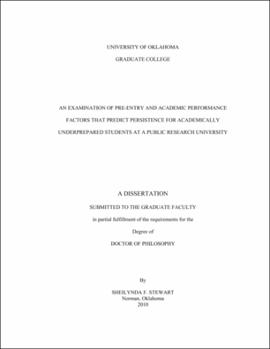| dc.description.abstract | The purpose of this study was to examine student demographic, family characteristics, pre-college, and college academic factors that predict persistence between freshmen students who were placed or not placed in remediation courses. The participants for this study were comprised of 3,213 first-time, full-time and part-time, degree-seeking freshmen students enrolled at the University of Oklahoma during the fall 2006 through the fall 2008 semesters. Tinto's longitudinal model of institutional departure (1993) is widely utilized and focuses on traditional college students at four-year colleges and universities. Therefore, Tinto's model was appropriate for this study for examining demographic, pre-entry, family, and college academic performance variables that predict persistence of first-time entering traditional college students at a four-year public university. Quantitative methodology using an ex post facto design, Factorial Analysis of Variance (ANOVA), Pearson's product-moment correlations, and stepwise multiple regression, was utilized in this study to examine group differences on persistence after the independent variables had occurred. The findings of the study revealed (1) that females accounted for 59.6% of the students placed in remedial courses, while males accounted for 40.4% of the students placed in remedial courses, (2) there were statistically significant mean differences at the .01 percent level obtained for ethnicity, financial aid, and remedial status on persistence, (3) that there was a statistically significant relationship at the .01 percent level between high school GPA, first semester college cumulative GPA, ACT composite scores, and persistence, and (4) academic factors that predict persistence revealed that first semester college cumulative GPA and high school GPA were statistically significant predictors of persistence and together accounted for slightly over 26% of the variance. Implications and recommendations from this study suggest that a collaboration from higher education stakeholders is needed to develop an academic plan or centralized advising center to assist sophomores with selecting a major, time management, campus resources, and future goals to increase persistence and graduation rates. Administrators and faculty should work to develop programs to address the retention needs of second year students. Further research should be conducted to examine how participation in co-extracurricular activities, living and learning on-campus communities, campus climate, and social integration and institution commitment components contribute to student retention and persistence. | |
